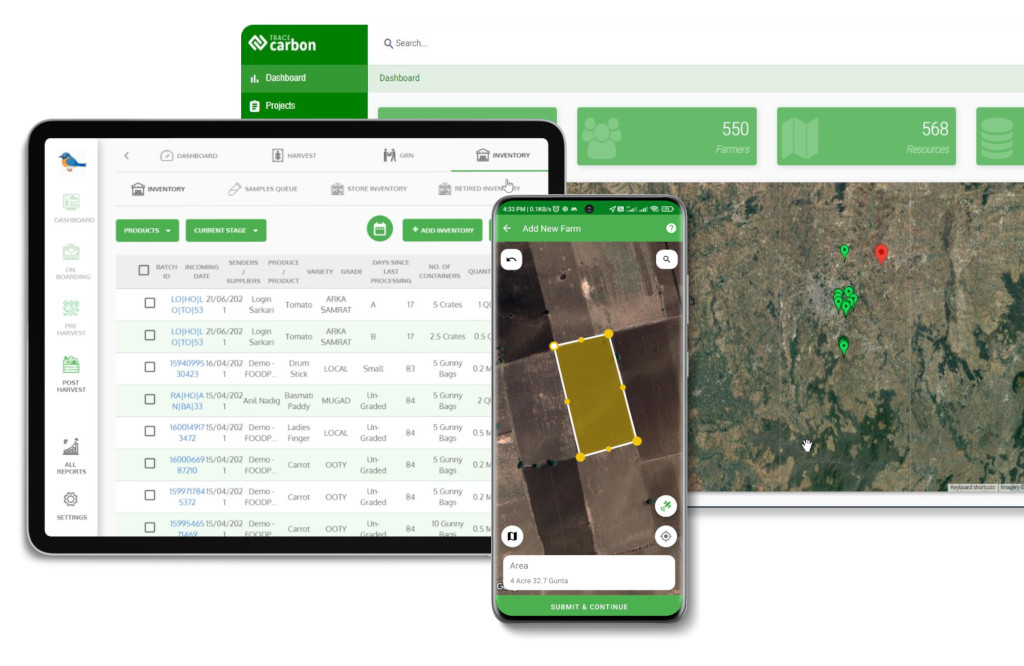Contact: +91 99725 24322 |
Menu
Menu
Quick summary: Learn how to report multiple farm plots in a single EUDR Due Diligence Statement (DDS) while meeting EU traceability, geolocation, and deforestation-free requirements—plus best practices for efficient, compliant submissions.

To report multiple farm plots in a one EUDR Due Diligence Statement (DDS), exporters must ensure all plots are linked to the same supply chain actor and product batch, with traceable, compliant geolocation data for each farm. Each plot—whether a point or polygon—must be individually verified for deforestation-free status and legal land use. These can then be grouped in a single DDS submission through the EU TRACES portal if documentation and risk assessments are consistent across the batch.
Many exporters assume that each farm requires a separate EUDR Due Diligence Statement (DDS)—but that’s not always the case. The regulation allows multiple smallholder plots to be grouped under a single DDS, provided they meet key criteria: same operator, identical product, single shipment or lot, and fully traceable, compliant geolocation data.
This flexibility helps reduce administrative burden, but confusion remains around how to structure, verify, and justify these groupings without triggering audit flags. In this guide, we explain what EUDR permits, how to group plots effectively, and how to stay compliant while saving time and reducing risk exposure.
Key Takeaways
The EU Deforestation Regulation (EUDR) permits operators to report multiple farm plots in a single Due Diligence Statement (DDS)—but only under tightly defined conditions. All plots must be located in the same country, pertain to the same commodity, and be backed by uniform traceability and deforestation risk profiles. This isn’t about shortcuts—it’s about smart, risk-aligned documentation.
Grouping plots is often misunderstood as a “mass balance” tactic, but under EUDR, it’s actually a risk management strategy. If all plots can be individually traced, geolocated, and proven deforestation-free, then batch reporting enhances efficiency without compromising transparency. However, every plot within that group must pass the same deforestation and legality checks, and any deviation—even from one—jeopardizes the entire DDS.
Imagine an exporter in Ghana sourcing cocoa from 10 mapped farms, each under 4 hectares. The farms are part of a certified cooperative, share uniform harvest timelines, and were verified against 2020 satellite imagery using buffered point plots. All show no deforestation risk and are covered by legal documentation.
These plots can be legitimately grouped into one DDS, submitted via the TRACES portal.
It’s not about farm size—it’s about data integrity and traceability consistency. If one plot has missing documentation, inconsistent harvest cycles, or proximity to recent forest loss, it could trigger a non-compliance risk for the entire batch.
Under the EU Deforestation Regulation (EUDR), each Due Diligence Statement (DDS) must include geolocation coordinates, confirmation of legal land use, and proof that no deforestation has occurred on or after 31 December 2020. But EUDR does not mandate a “one plot, one DDS” rule. Instead, it allows multiple plots to be reported in a single DDS—if they meet three strict conditions:
This allowance is essential for aggregator-based models, where thousands of smallholder plots may contribute to a single export batch. Requiring one DDS per farm would overwhelm both operators and authorities. Instead, the regulation takes a risk-based, batch-level view—encouraging responsible group reporting as long as traceability and risk assessments are credible.
Don’t group plots just because they’re small—group them because they’re geographically and operationally cohesive, and risk-classified consistently. Always retain the underlying farm-level records, even when reporting as a batch.
Are you a producer company navigating EUDR?
Read: How Producer Companies Can Achieve EUDR Compliance Step-by-Step
Need help filing your Due Diligence Statement (DDS)?
Explore: How to File a DDS in the EU TRACES Portal — A Practical Guide
Under the EUDR, geolocation isn’t just a supporting document—it’s the foundation of your Due Diligence Statement (DDS). Whether you’re working with 5 farms or 5,000, how you structure and validate your geolocation data directly impacts your traceability credibility, risk score, and export viability.
When reporting multiple farm plots in a single DDS, you must include a separate GeoJSON entry for each plot. This can be structured as:
Each plot must be represented as either a point (for <4 ha) or a polygon (preferred for larger or high-risk zones).
Learn how GeoJSON-based farm mapping helped the tyre industry align with EUDR requirements.
Read the Case Study: GeoJSON Mapping for Deforestation-Free Rubber Supply Chains
Under EUDR, point geolocation is acceptable for farms smaller than 4 hectares, particularly when full boundary mapping is not feasible. These points must include accurate latitude and longitude, and ideally plot size metadata, all validated with on-ground data. In contrast, polygons are required for larger farms or those located in high-risk zones—such as near forest frontiers or protected areas. Polygons must precisely represent the farm perimeter and comply with EU geometry integrity rules, meaning they must be closed shapes with no self-intersections, gaps, or geometric errors. Accurate formatting directly affects the credibility of your DDS submission.
It’s not just about coordinates. Each geolocation record should be accompanied by:
Why? Because this metadata enables cross-verification across legal land use documents, harvest declarations, and deforestation checks. It’s how auditors know your plots aren’t just mapped, but anchored in reality.
A well-structured geolocation file isn’t just about EUDR 2025. It’s your entry ticket to future sustainability, MRV (monitoring, reporting, verification), and ESG reporting. Poorly validated coordinates or incomplete metadata can derail entire shipments, damage reputations, and lead to market rejection.
Under the EU Deforestation Regulation (EUDR), when multiple farm plots are grouped in a single Due Diligence Statement (DDS), each individual plot must pass the threshold of “negligible risk”. The regulation doesn’t average risk across the group; instead, it treats the entire DDS batch as non-compliant if even one plot fails on legality, traceability, or deforestation status. This places a sharp compliance edge on how risk is assessed—plot by plot, not just batch-wide.
EUDR’s risk framework requires operators to:
In a multi-plot DDS, these checks are not optional. If a plot is near forest loss, lacks proper documentation, or presents unclear land tenure, the entire DDS may be rejected or flagged for audit.
Think of multi-plot DDS submission like a chain of custody: it’s only as strong as its weakest link. Including one risky or poorly documented farm can invalidate the traceability of an entire shipment, exposing the exporter to reputational damage, shipment delays, or EU market access loss. This is especially critical for smallholder-based models, where inclusion pressure can override cautious risk vetting.
Tools That Auto-Score Risk Per Plot
Modern compliance platforms now offer per-plot risk scoring tools, evaluating:
These tools assign a risk grade or flag per plot (e.g., Green = negligible risk, Red = high risk), allowing exporters to exclude, mitigate, or seek supporting evidence before finalizing the DDS.
Risk assessment under EUDR isn’t just a checkbox—it’s an opportunity to future-proof your supply chain. Exporters that build plot-level risk transparency into their sourcing models will not only comply more efficiently, but also gain competitive leverage with EU buyers seeking credible, deforestation-free sourcing.

TraceX EUDR Compliance Platform simplifies reporting multiple farm plots in a single EUDR DDS by digitally linking each plot—point or polygon—to verified farmer profiles, harvest data, and risk assessments. The platform auto-validates geolocation checks deforestation status per plot, and ensures all plots meet the “same operator, same commodity, same country” rule required by EUDR. It then auto-generates a single, batch-level DDS with traceable, audit-ready documentation, ready for submission via the EU TRACES portal.
Reporting multiple farm plots in a single EUDR DDS is both permissible and practical—as long as plots share the same product, country of origin, and uniform risk profile. By consolidating traceable, compliant plots into batch-level submissions, producer companies can reduce redundancy, accelerate DDS workflows, and maintain strong audit integrity. With the right digital tools, even fragmented smallholder networks can be aligned into a single, validated due diligence process that meets EUDR standards and simplifies EU market entry.
Need clarity on farm mapping rules?
Read: Geolocation Requirements for EUDR—Points, Polygons & Precision
Worried about deforestation risk scoring?
Explore: How to Conduct EUDR-Compliant Risk Assessments
Preparing your first DDS?
Guide: EUDR Due Diligence Explained—What Operators Must Know
Yes, if the commodity and country are the same, and traceability data meets EU standards.
Yes, each plot must be individually mapped (point/polygon) and included in the DDS submission.
If one plot is non-compliant, the entire DDS may be rejected—making proper risk assessment essential.
